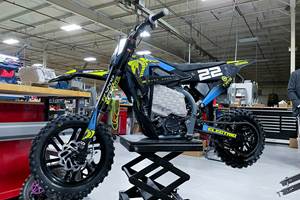Video: Where Are We Heading with Additive Manufacturing?
Increasing demands for additive end-to-end production processes, machine learning and product customization are driving additive manufacturing forward. Peter Zelinski explains where he thinks AM is heading in this video.
Peter Zelinski, editor-in-chief of Additive Manufacturing, opened the 2018 Additive Manufacturing Conference (now Formnext Forum) with remarks that summarized where additive manufacturing (AM) was in 2018, and where it will likely go in the future.
6 Ways Additive Manufacturing Will Likely Progress
-
Production is where additive manufacturing technology is headed. Additive manufacturing has been held back by challenges related to speed, control, economy and automation. Recent advances to surmount these obstacles clear the way toward scale production.
- AM reduces the need for shipping and logistics, creating an end-to-end manufacturing process. Additive manufacturing enables manufacturing compilations of different parts in a single build. Instead of building components on an assembly line from separately machined or molded parts shipped to the assembly location, an entire intricate product can now be made in one place, often in a single machine, making transportation is less of a concern. In this way, AM reduces the need for trucking and shipping.
- The future of AM will be aided by machine learning. Trial and error goes into additive builds today, but machine learning will make it possible for 3D printers to one day optimize the program and run without requiring as much experimentation from the operator. At the ADAPT center at the Colorado School of Mines, researchers are experimenting with laser settings, part orientation, layer thickness and powder characteristics to identify which values lead to a serviceable end result, with the goal of teaching computers and programs to make this identification. In the future, optimizing the AM process will be performed with the help of artificial intelligence.
- Additive is well-suited to highly controlled manufacturing. The contained process of AM lends itself to precise and accurate custom part creation in a single location or unit. One example is Next Step Arthropedix, a medical device engineering firm that developed a hip implant design leveraging AM. Unable to find an end-to-end AM supplier for their production, the firm decided to establish the process itself. Additive makes this opportunity available with no need for casting, forging or thermal spray that might otherwise make manufacturing difficult to consolidate.
- With the shift toward AM also comes a shift toward OEMs and inventors taking more of a hands-on role in creation of parts and processes. The manufacturer Liberty Electronics is using FDM 3D printing technology to make tools that are used in its own assembly processes. A project engineer at Liberty took the idea further and began creating custom tooling tailored to the needs of fellow employees who face physical challenges. The engineer recognized that 3D printing could provide a low-cost answer to these challenges. The simplicity of the part-making process enabled hands-on involvement in product creation.The engineer could take each custom tool to his coworkers and receive immediate input for any necessary changes or issues.
- AM can help set aside the concept of one-size-fits-all and move manufacturing towards innovative and individual customization. AM technology makes it possible and practical to iterate designs or manufacture custom variations in order to provide specific solutions to individual problems.
“Everything I have seen about the advances being made, the possibilities being explored, the extent to which additive is realizing its promise to transform, consolidate and simplify manufacturing … seeing all of that gives me heightened confidence that the future of manufacturing is what we are seeing,” Zelinski says.
Related Content
How Norsk Titanium Is Scaling Up AM Production — and Employment — in New York State
New opportunities for part production via the company’s forging-like additive process are coming from the aerospace industry as well as a different sector, the semiconductor industry.
Read More10 Important Developments in Additive Manufacturing Seen at Formnext 2022 (Includes Video)
The leading trade show dedicated to the advance of industrial 3D printing returned to the scale and energy not seen since before the pandemic. More ceramics, fewer supports structures and finding opportunities in wavelengths — these are just some of the AM advances notable at the show this year.
Read MoreNew Electric Dirt Bike Is Designed for Molding, but Produced Through 3D Printing (Includes Video)
Cobra Moto’s new all-electric youth motocross bike could not wait for mold tooling. Parts have been designed so they can be molded eventually, but to get the bike to market, the production method now is additive manufacturing.
Read MoreUnderstanding HP's Metal Jet: Beyond Part Geometry, Now It's About Modularity, Automation and Scale
Since introducing its metal binder jetting platform at IMTS in 2018, HP has made significant strides to commercialize the technology as a serial production solution. We got an early preview of the just-announced Metal Jet S100.
Read MoreRead Next
GE Additive Rebrands as Colibrium Additive
As part of the brand name transition, both the Concept Laser and Arcam EBM legacy brands will be retired.
Read MoreVideo: Intelligent Layering Metal 3D Printing at 3DEO
Contract manufacturer 3DEO delivers metal parts using Intelligent Layering, a binder jetting-like 3D printing process the company developed and operates internally. Here’s how it works.
Read MoreTo Improve Performance of Compression Molded Composites, Add 3D Printed Preforms
9T Labs' Additive Fusion Technology enables the manufacture of composite structures with as much or as little reinforcement as is necessary, using 3D printed continuous fiber preforms to add strength just where needed.
Read More










.png;maxWidth=300;quality=90)









